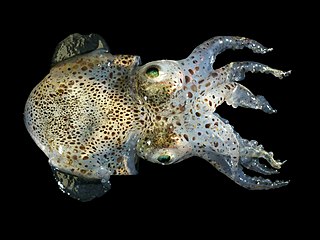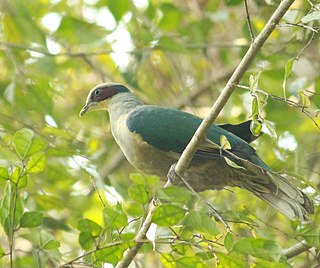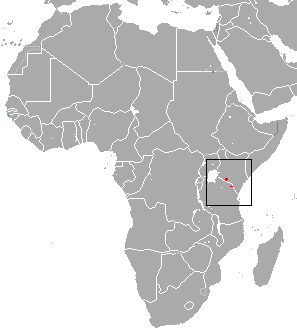
Fischer's chameleon, also known commonly as the Nguru blade-horned chameleon and the Nguru two-horned chameleon, is a species of chameleon, a lizard in the family Chamaeleonidae. The species is endemic to Tanzania.

Bobtail squid are a group of cephalopods closely related to cuttlefish. Bobtail squid tend to have a rounder mantle than cuttlefish and have no cuttlebone. They have eight suckered arms and two tentacles and are generally quite small.

The spectacled eider is a large sea duck that breeds on the coasts of Alaska and northeastern Siberia.

Aliivibrio fischeri is a Gram-negative, rod-shaped bacterium found globally in marine environments. This species has bioluminescent properties, and is found predominantly in symbiosis with various marine animals, such as the Hawaiian bobtail squid. It is heterotrophic, oxidase-positive, and motile by means of a single polar flagella. Free-living A. fischeri cells survive on decaying organic matter. The bacterium is a key research organism for examination of microbial bioluminescence, quorum sensing, and bacterial-animal symbiosis. It is named after Bernhard Fischer, a German microbiologist.

Fischer's lovebird is a small parrot species of the genus Agapornis. They were originally discovered in the late 19th century. They are named after German explorer Gustav Fischer.

Euprymna scolopes, also known as the Hawaiian bobtail squid, is a species of bobtail squid in the family Sepiolidae native to the central Pacific Ocean, where it occurs in shallow coastal waters off the Hawaiian Islands and Midway Island. The type specimen was collected off the Hawaiian Islands and is located at the National Museum of Natural History in Washington, D.C.

The red-eared fruit dove is a species of bird in the pigeon family. It is endemic to the island of Sulawesi, Indonesia.

Fischer's turaco is a species of bird in the family Musophagidae. It is found in Coastal East Africa, including Kenya, Somalia, and Tanzania. Its natural habitats are subtropical or tropical moist lowland forest, subtropical or tropical moist montane forest, and arable land. It is threatened by habitat loss and trapping for the wildlife trade.

The straw-tailed whydah is a species of bird in the family Viduidae. It is found in Ethiopia, Kenya, Somalia, South Sudan, Tanzania, and Uganda. Its natural habitat is dry savanna. Like all other whydah species, the straw-tailed whydah is a brood parasite.

Fischer's shrew is a species of mammal in the family Soricidae. It is found in Kenya and Tanzania. Its natural habitat is dry savanna.

The Fischer's pygmy fruit bat or Philippine pygmy fruit bat is a species of megabat in the family Pteropodidae. It is monotypic within the genus Haplonycteris. It is endemic to the Philippines. Its natural habitat is subtropical or tropical dry forests.
The fanfin skate is a species of skate in the family Arhynchobatidae. It is the only species in the monotypic genus Pseudoraja. This pelagic skate occurs in the Atlantic Ocean from Florida and through the Gulf of Mexico to Honduras.
Johann Gustav Fischer was a German herpetologist.

Acrotylus is a genus of grasshopper in the family Acrididae and the type genus of the tribe Acrotylini.

The slender burrowing grasshopper is a species of bandwing grasshopper found throughout Africa, southern Europe and southwestern Asia. It occurs in many dry open habitats with bare ground, such as savannah, grassland and Mediterranean shrubland.

Eoconstrictor is an extinct genus of booid snake, which supposedly had infrared vision, from the Eocene of Germany. The type species, E. fischeri is known from multiple well-preserved specimens found in the Messel Pit of Germany. It was originally named as Palaeopython fischeri by Stephan Schaal in 2004, but examination of the genus showed that it represented a distinct lineage; it was renamed as the new genus Eoconstrictor in 2020. In a subsequent study Georgalis, Rabi & Smith (2021) reinterpreted "Paleryx" spinifer from the Eocene Geiseltal Lagerstätte as the second species species belonging to the genus Eoconstrictor. Palci et al. (2023) named the third species belonging to this genus, E. barnesi described on the basis of fossils from the Geiseltal Lagerstätte.
Trachelosaurus is an extinct genus of lizard-like early archosauromorph reptiles from the Protorosauria within the monotypic family Trachelosauridae that was originally described as a dinosaur until it was redescribed in 1988 by Robert L. Carroll. The type species, T. fischeri, was described by F. Broili & E. Fischer in 1917 based on remains found in the Solling Formation (Buntsandstein), Bernburg, Germany.

Acrotylus insubricus is a species of band-winged grasshopper in the family Acrididae. It is found in Europe, Africa, and Asia.

Acrotylus longipes is a species of band-winged grasshopper in the family Acrididae. It is found in Europe, North Africa, and western Asia.

Anisolophus is an extinct genus of proterotheriid from the Early to Middle Miocene of Argentina. The genus was named by Burmeister in 1885 to accommodate the species Anchitherium australe, which they had named earlier in 1879. Soria then referred the species Licaphrium floweri and Anisolophus minisculus to the genus, making Licaphrium, named in 1887 by Florentino Ameghino, a junior synonym of the genus. Both A. australis and A. floweri are known from the Santacrucian age Santa Cruz Formation, while A. minisculus is known from the Collón Curá Formation.
















